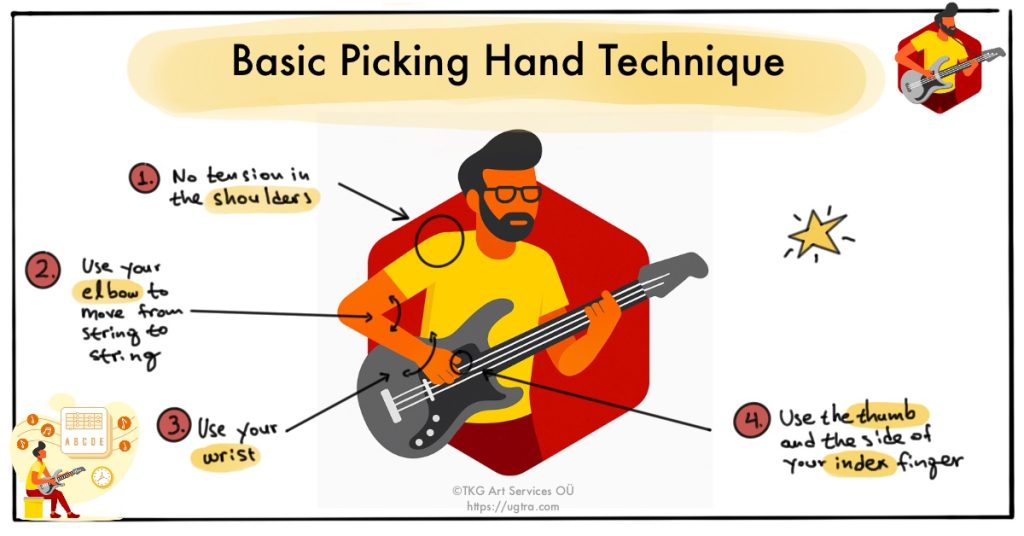The Secret Fix for Sloppy Alternate Picking: Master the Right-Hand Motion First
[This piece comes from my Guitar Technique Booster Course. It’s focused on the fundamental picking-hand mechanics and has been lightly adapted for this article.]
The Foundation: How to Hold the Pick
The way you hold your pick is the starting point for mastering alternate picking. A proper grip ensures stability, control, and efficiency of motion.- How to hold the pick: Use your thumb and the side of your index finger to grip the pick. Avoid pinching too tightly, as this creates unnecessary tension in your hand.
- How much pick should be showing: Expose 1–3 mm of the pick. This ensures the pick doesn’t dig too deep into the string, reducing resistance and preventing snagging.
- Pick angle: For alternate picking, edge picking is ideal. By angling the pick slightly, you reduce resistance, allowing for smoother and faster motion. It’s also in position to execute pinch harmonics easily. For strumming, use the flat part of the pick for a fuller, more balanced tone.
The Motion: Wrist vs. Elbow
One of the most common questions among guitarists is: “Should I use my wrist or elbow for alternate picking?” The answer lies in understanding the roles of each.
- Wrist movement: The primary motion for alternate picking comes from the wrist. This allows for small, controlled movements that are essential for speed and precision.
- Elbow movement: Use your elbow to adjust the position of your picking hand when moving between strings. It’s not the source of the picking motion but a tool for navigating vertically from string to string.
Picking-Hand Position: Anchoring vs. Floating
Your picking-hand position plays a crucial role in maintaining control and reducing string noise.
- Resting the palm: When playing lead lines, rest the lower part of your palm lightly on the bridge. This stabilizes your hand without restricting movement.
- Avoid anchoring fingers: Do not anchor your pinky or other fingers on the guitar body. Anchoring can limit your range of motion and create tension.
- Floating right hand: For chord strumming, let your hand float freely. This allows for a more dynamic and expressive sound.
- Chordal picking: When arpeggiating chords, anchoring your pinky lightly on the guitar body can provide additional stability.
Finger Position: Open vs. Closed
Should your picking-hand fingers be open or closed? Both are technically correct, but I recommend keeping your fingers open. Here’s why:
- Hybrid picking: Open fingers allow you to incorporate hybrid picking seamlessly into your playing. This technique, used by players like Brett Garsed and Guthrie Govan, combines pick and finger techniques for a versatile sound.
- Tapping and harmonics: Open fingers make it easier to execute advanced techniques like tapping and tap harmonics.
Efficiency of Motion: The Key to Speed
Speed isn’t only about how fast you can move your hand—it’s about how efficiently you can move it too. Here are some tips to optimize your picking motion:
- Minimize movement: Keep your picking motion small and controlled. Excessive pick motion wastes energy and reduces speed.
- Wrist rotation: Use subtle wrist rotation to maintain a consistent picking angle across all strings.
Exercises to Reinforce Mechanics
Once you’ve mastered the fundamentals, it’s time to put them into practice. Here are a few exercises (guitar tab included) to solidify your picking-hand mechanics:👉 How To Improve Your Alternate Picking. A Strategic Approach to Master the most Common Guitar Technique.
[Further reading: 👉 Alternate Picking vs Economy picking (Sweep Picking). Which Guitar Picking Technique Suits Your Playing Style Best?]
Inspiration from the Masters
Great guitar players like Paul Gilbert, John Petrucci, Al Di Meola and Michael Angelo Batio have mastered alternate picking by focusing on mechanics first.
- Paul Gilbert: Known for his blazing speed and precision, Gilbert emphasizes the importance of small, efficient picking motions.
- John Petrucci: The Dream Theater virtuoso is celebrated for his impeccable alternate picking technique, combining speed, clarity, and control. Petrucci’s disciplined approach to practice and focus on efficiency of motion make him a benchmark for aspiring guitarists.
- Al Di Meola: A pioneer of jazz fusion guitar, Di Meola’s alternate picking is characterized by its precision and rhythmic complexity. His ability to blend speed with intricate phrasing has inspired countless players.
- Michael Angelo Batio: Renowned as one of the fastest guitarists in the world, Batio’s alternate picking technique is a masterclass in precision and efficiency. Known for his ambidextrous playing and jaw-dropping speed, he emphasizes the importance of clean, repeatable motions and a relaxed picking hand. Batio’s meticulous focus on mechanics allows him to execute complex lead lines and neoclassical runs with unparalleled clarity. His dedication to refining every aspect of his technique has made him a legend among guitar shredders and a source of inspiration for players aiming to push the boundaries of speed and technical mastery.
FAQ
Why do I miss strings when playing lead?
This usually happens because you’re not resting your wrist on the bridge. Resting your wrist lightly on the bridge provides stability and helps you maintain consistent string targeting. Without this anchor, your picking hand can drift, making it harder to hit the right strings accurately. Focus on keeping your wrist relaxed but stable, and you’ll notice an immediate improvement.
Why does my picking sound loud and percussive?
If your picking sounds overly loud or harsh, it’s likely because you’re digging the pick too deeply into the strings. This causes snagging and unnecessary resistance. To fix this, adjust your pick depth so only 1–3 mm of the pick is exposed to the string. This small adjustment will make your picking smoother and less aggressive, while still maintaining clarity and control.
Why does the pick keep falling from my hands?
This is a common issue caused by either gripping the pick too tightly or too loosely. You need to find the sweet spot, firm enough to keep the pick secure, but not so tight that it creates tension in your hand. Use your thumb and the side of your index finger to hold the pick, and experiment with grip pressure until it feels natural and stable.
What guitar picks do you use?
I’ve been using the Dunlop Jazz 3 for over two decades. It has the perfect balance of shape, size, and thickness, making it ideal for precision, speed, and control. Whether you’re shredding lead lines or working on intricate picking patterns, this pick delivers every time. If you haven’t tried it yet, I highly recommend giving it a shot, it might just become your go-to pick too!
Final Thoughts
Mastering alternate picking isn’t always about finding the perfect exercise. It’s rather about perfecting the mechanics. First, focus on your picking-hand position, motion, and efficiency. Doing this will help you gain the speed and precision you’ve been chasing.
Remember, speed and smoothness are the result of clean, repeatable motion. Fix the basics first, and the rest will follow. As Jim Rohn once said, “Discipline is the bridge between goals and accomplishment.”
So, pick up your guitar, focus on the fundamentals, and let your journey to mastery begin. 🎸


Pingback: Basic Fretting Hand Guitar Technique: Building a Solid Foundation for Speed and Precision - The UGtrA Zone